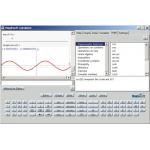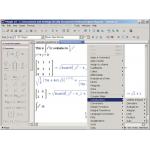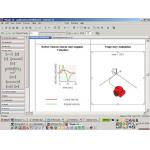Latest News
June 1, 2005
By Barry Simon
Wow! Upgrades of mature products can introduce significant enhancements, but they rarely make you think you’re using a totally different product. While the new $1,995 Maple 10 can be opened and used in its familiar DOS-like command line or worksheet (command line with text and graphics regions), the default is a spiffy new interface that has much more the look and feel of Mathsoft’s (Cambridge, MA; mathsoft.com) Mathcad but with Maple’s incredible power underneath.
Maple’s Core
Maple’s mathematical core is the same with a few enhancements. You can compute to arbitrarily high accuracy, do exact rational arithmetic, and use thousands of algorithms to manipulate symbolic expressions including symbolic calculus. You can define and compute with matrices.
There are also thousands of built-in functions including statistics, special functions, and data manipulation. If you need to go beyond the built-in functions, Maple has a BASIC-like programming language that lets you define your own functions for reuse and do complex numeric or symbolic computations
 |
| Figure 1: Documents produced with Maple can have graphics and animation. Click on image to enlarge. |
There is a rich array of two-dimensional and three-dimensional graphics, including the ability to animate (see Figure 1, right). With a few clicks you can define a function depending on a parameter and see an animation of how its graph varies as this parameter is varied. The tools for studying 3D graphics interactively are superb. Document Mode
Maple calls its brand new interface document mode. Steve Jobs once joked if you ever saw the Unix underlying the current Apple OS, it was a bug. While that’s not quite true of the design of Maple document mode, the command line is hidden and will be rarely used, at least when doing relatively simple tasks. Instead, you enter expressions very much like you would in a WYSIWYG technical word processor and manipulate them by right-clicking and choosing from a context-sensitive menu (see Figure 2, below left).
 |
| Figure 2: Maple 10’s document mode has extensive right-click menus. Click on image to enlarge. |
For the most common complex tasks like curve fitting, ODE (ordinary differential equation) solving, and matrix manipulation, you can call up assistants that will take you through the steps necessary to accomplish the tasks. Maple “understands” thousands of mathematical symbols, and the flexibility of the new interface is shown by the multitudinous ways they can be entered.
There are symbol palettes that can be individually opened along the left side, you can type in a symbol name if you know it, or type the first few letters and ask Maple for a list of possible completions, or you can use a new drawing mode. With a mouse (or stylus should you have a tablet PC), you draw a symbol and pick from the possible matches that Maple finds (see Figure 3, below right).
 |
| Figure 3: Symbol entry can be done by drawing with a mouse or by entering part of a name and using name completion. Click on image to enlarge. |
While some users will be able to get away without ever learning Maple’s detailed syntax for command entry, it is likely if you do anything beyond the simplest tasks, you’ll need to access that language. For example, one test calculation gave me a nested set of radicals. To reduce to a single radical, I had to know about the “simplify” function with parameter “radical.” It was easy to select the answer, right-click, choose “Apply a command,” and type in the command name and parameter into the dialog box.
Another potential downside of document mode that you need to be aware of is that entry of letters can be either in math mode or text mode—and only math mode can get evaluated. Once you enter in one mode, there is no documented way to shift what you’ve typed into the other mode except by deletion and reentry. So, you’ll need to be aware throughout which mode you are in.
On the plus side you produce word processor-quality documents with mathematical expressions in a way that you can change some input data in the text, click a single button, and have the entire document reevaluated using the new data. The result is that document mode has a look and feel traditionally associated with Mathcad but with Maple’s more powerful engine underneath.
ODEs are particularly easy to manipulate in document mode since you can enter them using the apostrophe key to put in a Newtonian prime for derivative and then invoke the ODE assistant to choose numeric or symbolic solution, enter initial conditions, and get output in tables.
Document mode has some of the rough edges you associate with first versions. For example, if I entered an integral sign (using the Common Symbols palette rather than the Expression palette) and then typed “x^2 dx” and hit evaluate, I got a cryptic error message. However, entering x^2 by itself, right-clicking, and choosing “integrate” or using the Expression palette worked fine. This doesn’t prevent this mode from being potentially very useful, especially to the occasional user, but it does leave room for improvement.
Units and Errors
Two especially neat features of Maple 10 that will be welcomed by practicing engineers involve the handling of units and of errors. Any variable or number can be assigned one of more than 500 units, and unit conversion is as simple as right-clicking and picking a new unit. You can add together compatible units in different systems and track the units of any calculated quantity.
Any variable can be assigned errors; i.e., given a range of values. Numeric calculations with these quantities then return the combined errors in the results. Maple also knows the values of more than 20,000 physical constants, and has a built-in dictionary of more than 5,000 mathematical and scientific terms.
While the focus in this new version is on the brand new user interface, there are numerous improvements in the guts of the program. The set of algorithms available to solve ODEs has been vastly expanded, and there are new packages of statistical functions, including functions that allow interactive data analysis and SPC (statistical process control).
On the programming side, complicated functions can now be compiled to C code. For distributing Maple code to others there is a new Installer package. There are new programming tools for manipulating audio and image data.
 |
| Figure 4: The Maple Scientific Calculator can do simple plots. Click on image to enlarge. |
Besides the three modes already mentioned, the new Maple has a fourth mode where it looks like a scientific graphing calculator, only this scientific graphing calculator understands complex exponentials and can compute determinants of matrices (see Figure 4, right). This applet is a pleasure to use. However, the interface is sometimes clunky—e.g., if you try to enter the sine function by typing “sin” or by looking for it on the list of trig functions, you can’t—you must use the button labeled “sin” in the button area.
MapleNetBy the time you read this, Maplesoft expects to release MapleNet, a product for the web that allows Maple worksheets and documents to be posted on a website and read by browsers even though the client machine does not have a copy of Maple. This adds to the burgeoning array of methods for posting complex mathematics on the web. (Editor’s Note: Click here to access MapleNet demos.)
The new Maple interface is the most exciting development I’ve seen in high-end mathematics packages in several years. Sophisticated users will still need to go to the command line and even user-written programs. Still, even such power users will find the new interface a pleasure to use, especially if they haven’t mastered all the ins and outs of Maple syntax. Any Maple user will want to upgrade to version 10, and users of similar products will want to give this new version a very close look.
Contributing Editor Barry Simon is chairman of the math department at the California Institute of Technology. You can send him your thoughts about this article via e-mail c/o DE‘s Editors.
Maple 10
Maplesoft
Waterloo, ONT
Price: $1,995
Requirements: Windows 98 or later, 512MB RAM (recommended), 400MB disk space
Subscribe to our FREE magazine, FREE email newsletters or both!
Latest News
About the Author
DE’s editors contribute news and new product announcements to Digital Engineering.
Press releases may be sent to them via [email protected].






